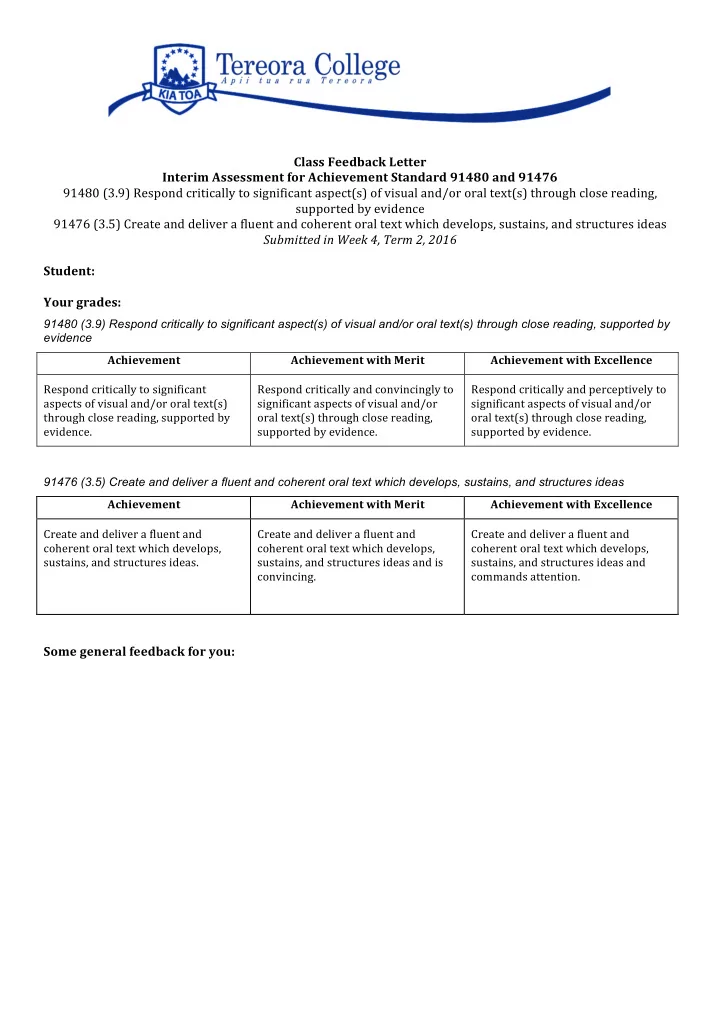

Class Feedback Letter Interim Assessment for Achievement Standard 91480 and 91476 91480 (3.9) Respond critically to significant aspect(s) of visual and/or oral text(s) through close reading, supported by evidence 91476 (3.5) Create and deliver a fluent and coherent oral text which develops, sustains, and structures ideas Submitted in Week 4, Term 2, 2016 Student: Your grades: 91480 (3.9) Respond critically to significant aspect(s) of visual and/or oral text(s) through close reading, supported by evidence Achievement Achievement with Merit Achievement with Excellence Respond critically to significant Respond critically and convincingly to Respond critically and perceptively to aspects of visual and/or oral text(s) significant aspects of visual and/or significant aspects of visual and/or through close reading, supported by oral text(s) through close reading, oral text(s) through close reading, evidence. supported by evidence. supported by evidence. 91476 (3.5) Create and deliver a fluent and coherent oral text which develops, sustains, and structures ideas Achievement Achievement with Merit Achievement with Excellence Create and deliver a fluent and Create and deliver a fluent and Create and deliver a fluent and coherent oral text which develops, coherent oral text which develops, coherent oral text which develops, sustains, and structures ideas. sustains, and structures ideas and is sustains, and structures ideas and convincing. commands attention. Some general feedback for you:
Dear 3ELIT, Excellent work! You guys picked up the challenge that I laid down and really made it work for you. To most of us this was a new way of doing assessment, and I’m really pleased with how it went. Below I’ll go through: the expectations of the assessment; your strengths with the close viewing part of the assessment; your weaknesses with the close viewing part of the assessment; your strengths with the oral text part of the assessment; and finally your weaknesses with the oral text part of the assessment. Expectations You conducted a close critical response to an unstudied scene from The Tempest , choosing aspects and critically responding to their use, meaning/s, and effect/s in the scene, providing specific evidence. You then presented your ideas in the form of an oral presentation, which might have been live or in a recorded format. This task allowed you to present evidence towards two different standards, the achievement criteria for which are above. In order to do well here your close viewing needed to be detailed and focused clearly on the aspects you were discussing – if you were talking about lighting, for example, then the more you focused in on and kept coming back to the lighting with various different examples, the more convincing and perceptive you tended to become. I was expecting to hear about the aspects’ effect/s on or meaning/s for the audience, and what Julie Taymor was trying to get us to realise/understand/etc by using them in that way (not necessarily using exactly those words). To achieve with Merit or Excellence you also needed to show how two or more aspects worked together to create a combined meaning or effect. In order to do well in the oral text side of things, your presentation needed to be coherent, which means that you had put time and effort into making sure it was clear, easy to understand, and engaged interest. It also needed to be fluent, which meant that you knew what you were saying, and could speak clearly and confidently, using oral and body language features to hold attention and help the audience understand your ideas as you developed and structured them. I loved watching and listening to your presentations. I was, in the first place, really impressed with the quality of the critical response you developed. I was then delighted by the effort that you put into presenting this analysis orally, whether it was a video or a live presentation. You all generally worked hard on your presentations and it really showed. It took me a handful of hours altogether to work through them, but it was a very enjoyable handful of hours. Close Viewing: Strengths The standard defines ‘close reading’ as a ‘detailed exploration and consideration’ of the aspects you’ve chosen to analyse. ‘Exploration’ really suggests the idea of digging around in all the details of the aspects. Those of you who achieved all did this to some extent. Those students who stuck close to the aspects and the scene tended to develop more convincing or perceptive analyses. To achieve, the standard says your critical response needed to be making ‘evaluative interpretations and judgements’ of the aspects you’ve chosen. There were many different examples of such interpretations and judgements of of meaning (basically, what it makes the audience think about/realise/understand) and effects (basically, how it makes the audience feel/react). Here are some paraphrased examples: The setting of the scene in which Antonio and Sebastian try to murder Alonso and Gonzalo looks like • the bars of a prison and shows how they are all trapped. • High and low angles of the characters in this scene also demonstrate who has power and who is powerless. The tightening of Prospera’s corset in the confrontation scene underscores how she has become again • who she once was. • Close ups in the confrontation scene help us connect with and understand Prospera more deeply. The confrontation scene is brightly lit which represents Prospera’s forgiving change of heart. • Most of these could have been developed into Merit-level critical responses by digging more deeply and discerningly into the meanings and effects created (audience reaction, director’s purpose, etc).
Recommend
More recommend